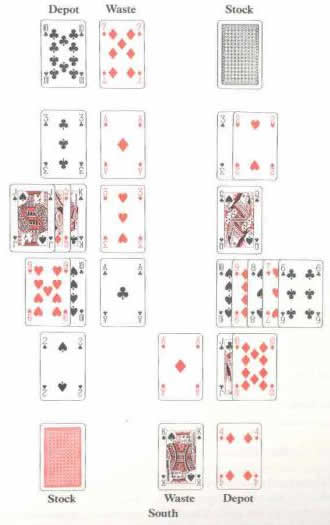RUSSIAN BANK
RUSSIAN BANK is similar to some patience games, in that cards are built on foundations, but it is a competitive game. It is also called Crapette and Stop!
NUMBER OF PLAYERS
Russian Bank is for two players .
CARDS
Two full packs of 52 cars with different backs (for ease of sorting into two packs afterwards)are used. The cards rank from King (high) to Ace (low ).
Each player draws a card from one of the packs. The player with the lower card plays first. Each player has one complete pack, and each player shuffles his opponent’s pack and places it face down before his opponent. Players sit opposite each other.
The first player deals 11 cards face down to a pile to his right, turning the 12th card face up and placing it on top of the pile. This is his depot. He deals the next four cards face up in a column to his left so that the column runs from his left hand to his opponent’s right hand. This is his file. He places the rest of his cards face down to his left. This is his stock.
THE PLAY
The object is to pack onto the cards in the files in descending sequences of alternate colors. Cards should be packed outwards from the centre. Any Aces are played to a foundation column to the right of the file. The Aces in the foundation column are built up to King , as cards become available, in suit sequence.
The cards initially available are the card in the file and the card face up on the depot. One card in the file can be packed on another, and when a card in the file is packed upon, it is still available, and can be packed onto another card in the file provided all the cards packed on it are transferred with it. players of the patience online poker game Demon (or Canfield) will recognize the principles.

When the first player has completed his layout as described, he first moves any Ace from the file to its foundation space. The space created in the file is filled by the top card of the depot, and the next card in the depot is turned face up. He then makes any further plays available, filling spaces created from the depot each time, until no further plays are possible.
He then turns over the first card of his stock. If he can build it onto a foundation or pack it onto a file he does so and turns the next card and so on. When he finally turns a card which cannot be played to a foundation or file, he plays it to a waste heap to his right, next card from the stock face up to the waste heap ready for play on his next turn, and his current turn ends.
The second player then deals a depot, a file and a stock in the same way, so that his cards interlock with the first to form a complete tableau (the illustration shows a game in progress). The second poker player makes his moves as the first, but he has the advantage of also being able to build to his opponent’s foundations, and pack onto his opponent’s files.
He can also play from his own depot and file onto his opponent’s waste heap in either ascending or descending sequence, irrespective of suit of colour. However, he cannot pack onto his opponent’s waste heap from his own waste heap or stock.
Each player from now on has these options on his turn. Cards available for play are those exposed at the top of a file, dept or waste heap. A turn ends when a player cannot play a card from stock except onto his waste heap.
When a player’s stock is exhausted, he turns over his waste heap (without shuffling) to form a new stock. When his depot is exhausted, he fills spaces in his file from his stock.
Plays must be made in the following order:
A space in a file must be filled before any other play is made.
A player must play from his depot before he plays from his file or waste heap.
When a card is played from the depot, the next card must be turned face up before the next play is made.
A player must play to a foundation if possible, before playing to a file.
A player must play to a file if possible, before playing to a waste heap.
A player who sees his opponent violate any of these rules or make any other mistake may cry ‘Stop!’ before his opponent has made a further play, and thus bring his turn to an end. He then points out the mistake, retracts the wrong play and makes the play his opponent failed to. He then takes over the turn himself.
The poker winner is the first player to get rid of all the cards in his stock and waste heap.
